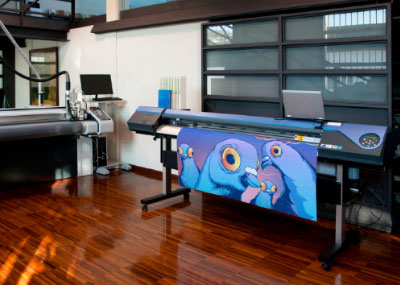Create Accurate Profiles on a Range of Textile Materials for Digital Printing
The advent of digital textile printing is disrupting the way fabric and apparel producers work. Although digital print technologies utilize more durable inks and offer higher reliability, longer print life, and overall cost savings and efficiency, these changes also mean print shops must adjust the way they operate to remain competitive.
First, the texture and stability of fabrics poses a challenge. Measuring coarse weaves with a standard print spectrophotometer can cause inconsistent results, so digital printers need to be more conscientious about color control to ensure the final color is accurate. Since materials are expensive, digital textile printers require accurate color management tools to profile up front and more frequent tolerance checks to verify color matches to avoid waste.
Plus, there are many new digital printing systems on the market today, from desktop printers that can print directly onto t-shirts and other fabrics to digital wide format and industrial printers for dye sublimation, direct to fabric, and roll to roll fabric. Some fabric can be produced short run on industrial sized machines, which is a big change in the printed fabric market. While printing small quantities on-demand reduces the need for large warehouses, print shops need to characterize both the device and the material together to do this successfully.
Using X-Rite profiling technology, digital printers can create more accurate custom color profiles on a broad range of textile materials, including organic, synthetic, weaves, and sublimation sheets, and check the accuracy of color throughout production for less wasted time and materials.
Customizable solutions from X-Rite Pantone provide digital textile designers and printers the ability to:
- Design across a range of materials with confidence in color reproducibility and consistency and obtain on-screen color accuracy for soft-proofing.
- Maintain consistent color between printers and reduce color variability across different materials and between jobs.
- Profile a range of textile materials, including those with optical brighteners.
- Check print quality using ISO 12647-7 compliant media wedges and trend display performance over time.
- Minimize back and forth trial and error to save time and materials for a faster, more accurate production workflow.
X-Rite Pantone’s comprehensive product solutions address challenges to achieve accurate and consistent color each and every time for digital textile technology industries.
Tools for Digital Textile Printing Color Management
X-Rite tools can ensure print quality on digital textiles regardless of process or substrate.
- i1Pro 3 Plus
- Visualize colors accurately before printing with included monitor profiling.
- Match multiple printers to achieve consistent, repeatable color from printer to printer, regardless of manufacturer or print process.
- Achieve better whites and shadows on textured materials with included polarization filter.
- i1iO Automated Measurement Table
- Judge QC Light Booth
Designed specifically for textiles, the i1Pro 3 Plus produces color profiles for a wide variety of textile substrates. Using the i1Pro 3 Plus with the included color management software allows you to calibrate and create custom profiles to:
When combined with the i1Pro 3 Plus, the i1iO Automated Scanning Table automates color profiling with hands-free test chart reading to speed up the process and reduce the risk of color measurement errors.
With 5 light sources including class B daylight and optional LED, this compact, entry level light booth is an economical way to visually evaluate the color of printed textiles under controlled lighting.
Why is Printer Profiling Important for the Digital Printing Process?
ICC color management helps digital printers reproduce the same color on different print materials. ICC color profiles are used for color reproduction between input and output devices. They define the relationship between the digital color on the device against a standard color space defined by the ICC (International Color Consortium).
All devices capable of producing color can use color management. By creating a profile for each input and output device, you can achieve the desired color on screen and in print.
Best Practices for Profiling Digital Textiles
To get the best measurement results on textile print production:
- Use a large measuring aperture to allow as much light as possible to enter the device. The 8 mm aperture on the i1Pro 3 Plus is ideal.
- Firmly anchor the material. The i1Pro 3 Plus comes with magnetic bars that work with an included backer board to ensure the fabric is dimensionally stable.
- Take multiple measurements per patch automatically with the i1Pro 3 Plus in scan mode or by using i1iO automatic scanning table.
- Choose the right measurement modes:
- Use M1 to capture fluorescent effects in fabric.
- Use M2 to eliminate fluorescent effects. In fabrics, it is helpful to cut the UV content when you are unsure of the final viewing condition and are primarily concerned with, just getting the right color on the final material.
- Use M3 to eliminate both the fluorescence effect and specular reflectance. The i1Pro 3 Plus M3 filter combines polarization and a UV filter.
Get Consistent Color for Specialty Media Printing
Get Consistent Color for Specialty Media Printing
Join industry experts David Zwang, Kristen Dettoni, and Felix Wijaya for a discussion about the challenges associated with digital textile printing and tips to achieve accurate color.
Join industry experts David Zwang, Kristen Dettoni, and Felix Wijaya for a discussion about the challenges associated with digital textile printing and tips to achieve accurate color.
디지털 텍스타일 프린팅시에는 각 소재별로 프로필을 작성하고, 선형화(linearization) 하여 높은 색 정확도를 달성하는 것이 중요합니다.
디지털 텍스타일 프린팅시에는 각 소재별로 프로필을 작성하고, 선형화(linearization) 하여 높은 색 정확도를 달성하는 것이 중요합니다.





